Weekly Fishing Report: August 16
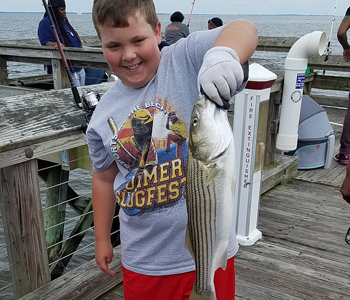
Brody Laffoon proves that you can also score while fishing from shore as he holds up this nice striped bass he caught off the Downs Park Fishing Pier. Photo by Kevin Laffoon.
Although the waters of the lower Susquehanna River and Flats area are still showing some stained water, it is a big improvement from last week’s conditions. Slowly the early morning striped bass bite at the dam pool is improving. Around the edges of the Susquehanna Flats, the early morning topwater action has been a mix of striped bass and largemouth bass. There are plenty of channel catfish in the area and those fishing with other lures mention that hungry catfish will chase down a soft plastic swimshad, a crankbait or even a jerkbait in a heartbeat.
Farther down the bay in the Pooles Island and Tolchester area, striped bass can be found at times chasing bait on top of the water. Many of the striped bass are less than 20 inches in length, but there are enough larger fish that those jigging or casting have been having good success. There is still good action at the Swan Point area for those chumming or live lining spot. Chumming tends to pull in a lot of smaller sized striped bass and small bluefish are showing up now also. Live lining tends to be an easier way to go if you can find a good supply of spot and can hold them onboard.
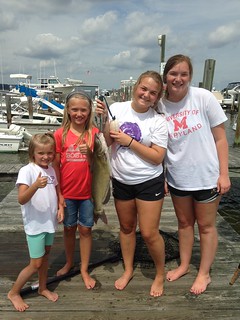
These girls are certainly happy with this Edgewater channel catfish. It has to warm anyone’s heart that one fish could bring so many smiles. Photo by Bill Goodwin.
This past weekend, most of the striped bass fleet moved back to the Podickory Point area along the 35 foot channel edge between Sandy Point Light and Baltimore Light. It was a big party out there with a large and dense fleet anchored up; some were chumming and others were live lining spot. Most seemed to have had good success with a very nice grade of striped bass over 20 inches in length. Small bluefish are now part of the equation in the upper bay and have been causing fits with the live lining tribe. Those chumming are not faring much better when losing hooks due to bite offs.
Trolling is an option in the upper bay this week and most are pulling a mix of small spoons, red surge tube lures, Storm type swimshads and bucktails behind inline weights to get lures down to where the fish are. Small bluefish are nipping off soft plastic twistertails and the tails of swimshads, which is no fun. The steeper channel edges in the bay have been the most productive places to troll at about 25 to 35 foot depths.
There has been good striped bass fishing at the Bay Bridge this week; most of the action has been taking place on the eastern side along the steep edge that drops from 30 to 70 feet. As a marker that general area is about the last rectangle set of bridge piers before the round piers start. It is a terrible place to anchor, so it takes someone at the helm to keep the bow nosed up current as anglers in the stern drift live spot, eels or cut bait back to the pier bases. Jigging with soft plastics is always a tried and true method to put a couple of nice striped bass in the boat.
White perch fishing remains good this week in the upper bay region in the tidal rivers and some of the shoals and knolls out in the bay. Fishing with bait tends to be the most popular method right now. There are certainly plenty of channel catfish to be found in the tidal rivers and upper bay areas.
Striped bass prospects are looking up this week for anglers in the middle bay region. The live lining of spot along channel edges has really changed things around in the last week or so. Good fishing is being found at a number of locations. Some of the best spots have been off Chesapeake Beach and the mouth of the Choptank River at the False Channel, RN 2 and the Diamonds. Live spot is the best way to get in on the action for a very nice grade of fish, bring plenty because bluefish are also in the area.
There continues to be some breaking fish being encountered at river mouths and shipping channel edges. The mouth of the West River has been popular and most of the time the surface action is made up of small striped bass and bluefish, with larger striped underneath and ripe for jigging.
Trolling a mix of red surge tube lures, spoons and bucktails are also a good option along channel edges or on the outside edges of breaking fish. Inline weights or planers are needed to get lures down to where the fish are. Trolling slowly in the lower sections of the tidal rivers with a mix of bucktails and diving jerkbaits or swim plugs can also be a good option to pick up a few striped bass here and there such as this nice one from the lower Choptank River.
Water temperatures still remain below 80 degrees Fahrenheit this week, and fishing in some of the shallower areas has seen an uptick in success rates. Speckled trout are being found in the lower Choptank and Little Choptank rivers and off Taylor’s Island. A few puppy drum in the legal slot are in the mix as well as striped bass and bluefish. Stump and fallen tree fields have been an excellent place to target in about 3-5 feet of water. Soft plastics and topwater lures have been very popular.
The lower bay region is bursting with fishing opportunities as several fisheries have shown a marked improvement. Cobia fishing in the area of the Middle Grounds to the Target Ship has been very good this week with dozens of large fish caught over the weekend. Most are being caught by chumming and drifting live eels, spot or cut baits back into the bottom of the chum slick. A mix of small inshore sharks, sting rays and bluefish are also part of the mix.
A mix of bluefish and Spanish mackerel are being found in the ship’s channel, often down deep. Planers or inline weights are needed to get small spoons down to where the fish are. Most are reporting little surface action to target so one needs to cover water to find the fish.
Better fishing for striped bass is being reported this week as a nice grade of striped bass have moved into the lower Potomac River around the Piney Point area and also near Cove Point. In the Potomac the fish tend to be holding along the steep channel edge there and are being caught by jigging, live lining spot or trolling. At Cove Point and the Gas Docks areas there are striped bass holding on the 35 foot channel edge and live lining spot is the best way to catch them. This location has a long history of being a striped bass hot spot especially when it comes to live lining spot and it would seem that it is coming back into play.
There is a wide variety of bottom fishing opportunities in the lower bay this week. Large spot can be found at the lower sections of the Patuxent and Potomac Rivers and the smaller rivers and creeks in the region east to the Tangier Sound area. Smaller spot can also be found in shallower areas but the large ones tend to be holding deeper along with a mix of kingfish, croaker and white perch. Speckled trout are in the mix when bottom fishing on the eastern side of the bay. They can also be caught with topwater lures and swimshads in shallower areas near marshes and creek mouths.
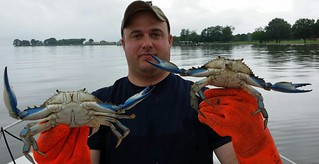
Ben Zero holds up a big pair of hefty crabs he caught while crabbing with a friend in the middle bay region. Photo by Travis Long.
Don’t forget to check the Click Before You Cast website for water quality updates and a forecast for fishing in the Bay. The website will be updated Wednesday afternoon with new information. Please feel free to send us any comments on this exciting new resource!
Recreational crabbers are enjoying good crabbing in the lower and middle bay tidal creeks and rivers and fair in the upper bay. Most are able to catch a half bushel or more of good solid crabs per outing. There are a lot of small crabs present and tend to be making short work of softer baits such as razor clams, so many are switching over to chicken necks. This is the time of the year for doublers and many are being seen this week.
A slight change to cooler weather has lowered water temperatures just enough to spur largemouth and smallmouth bass that are in a summer mode of behavior to become a little more active. The early morning bite at Deep Creek Lake and other reservoirs in the western region has been lasting longer into the morning as a result. Topwater lures are always the most fun way to fish along the shallower shorelines near grass and structure. Soft plastics and stick worms are a good bet in deeper waters near structure and once the bass begin to retreat to shade, flipping whacky rigged soft plastics under shade structure such as floating docks is the way to go.
Last weekend’s heavy rains had many streams and rivers in the western and central regions swollen with runoff but high waters are now down to more acceptable levels. One good thing is that water temperatures dropped some, which makes trout and other species more active which makes for better fishing. The catch and release trout management waters offer the best opportunities to enjoy good summertime trout fishing with fly fishing gear. A far different experience than dunking Powerbait or worms in the Put and Take trout stocked areas.
The upper Potomac is calming down after an earlier high water event and fishing conditions are once again safe and productive. Cooler water temperatures have the smallmouth bass a little more active this week. Targeting deep current breaks, boulders and submerged ledges is a good tactic. Topwater lures are perhaps the most fun and early morning is the best time to give them a try. As the day wears on, tubes, jerkbaits and crankbaits are good options.
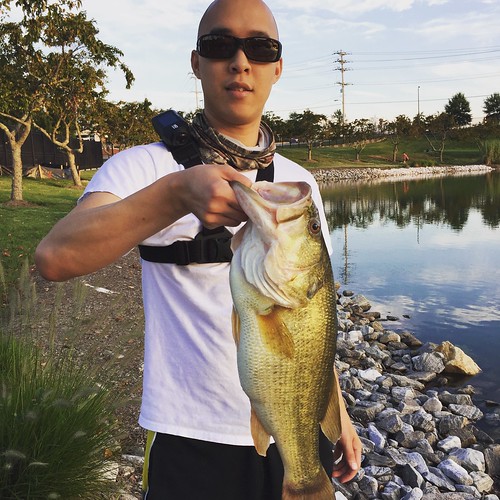
Photo courtesy of Stephen Mac, shown holding up a nice largemouth bass he caught and released from a Howard County pond recently.
The cooler turn in recent weather in the central, southern and eastern regions of the state has had a positive effect on several warm water fisheries. Largemouth bass in particular are reported to be more active during the morning and evening hours. This makes for some fun fishing action with topwater lures over or near shallow grass with frogs, buzzbaits, poppers or chatterbaits. In many areas of the Eastern Shore and Potomac River basin northern snakeheads will also be part of that topwater action. Tidal rivers often offer the best topwater action on a falling tide and when it is at low ebb and shallow grass and spatterdock fields are at their lowest water levels, targeting the outside edges with topwater lures, spinnerbaits and jerkbaits can be very productive.
Crappie should be holding tight to deep structure. In tidal rivers this can be marina docks or bridge piers, sunken treetops offer good structure in impoundments. Bluegill sunfish always seem to be active and for the younger set, a simple bobber and worm can bring a lot of joy and entertainment. They also offer a fun way to fly fish with rubber-legged poppers or wet flies or using small lures with ultra-light spinning tackle. Channel catfish offer a fun and relaxing way to fish from shorelines in many of the tidal rivers and blue catfish in the tidal Potomac offer a lot of action and good eating.
This year’s White Marlin Open provided plenty of drama for those watching the scales on the last day of the event. What was the leader and a respectable sized white marlin was beat out in the waning hours of the tournament with a 99.5 pound specimen, which a big white in anyone’s book and brought the Maryland angler and crew a sweet $1.65 million. Second place pulled in $1.5 million. The rest of the purse was spread between other categories, such as tuna, which paid out $866,553 for first place.
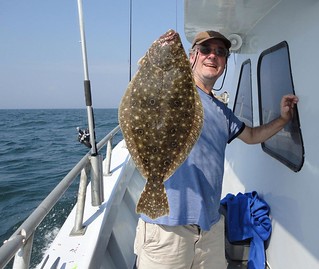
Photo courtesy of Richard Gunion, shown holding up a beautiful flounder caught on an inshore sea bass fishing trip.
Anglers with smaller prizes on their mind have been enjoying good surf fishing for a mix of summer species. Kingfish, spot, blowfish, flounder and small bluefish tend to round out the bill. Bloodworms, squid have been good baits and the bluefish are being caught on cut bait or finger mullet.
At the inlet, sheepshead and a few triggerfish are being caught along the jetties and bridge piers on sand fleas. Flounder are always a possibility and bluefish tend to move in and out of the inlet area at night.
The back bay action continues to focus on flounder and they are being caught in the channel areas of Assawoman and Sinepuxent bays. Sinepuxent tends to have less boat traffic and near the airport is often one of the better places to fish. Small sea bass are present as well as sea robins and blowfish.
Sea bass are being caught out at the inshore wreck and reef sites along with some respectable sized flounder. The best sea bass fishing is occurring far offshore on the inside of the continental shelf with blueline tilefish being part of the mix.
Based on the dockside results of the White Marlin Open, it is not hard to realize that offshore fishing for pelagic species has been slow this past week. Hopefully a water change will bring a resurgence of good fishing soon. At present there is a mix of yellowfin tuna out there in the canyon regions and a lot of chicken dolphin hanging out near sea bass and lobster pot buoys.
“There is certainly something in angling that tends to produce a serenity of the mind” –Washington Irving
 ABOUT THE AUTHOR Keith Lockwood has been writing the Fishing Report since 2003 and has had a long career as a fisheries research biologist since 1973. Over the course of his career he has studied estuarine fishery populations, ocean species, and over a decade long study of bioaccumulation of chemicals in aquatic species in New Jersey. Upon moving to Oxford on the eastern shore of Maryland; research endeavors focused on a variety of catch and release studies as well as other fisheries related research at the Cooperative Oxford Laboratory. Education and outreach to the fishing public has always been an important component to the mission of these studies. Keith is an avid outdoorsman enjoying hunting, fishing, bird dogs, family and life on the eastern shore of Maryland.
ABOUT THE AUTHOR Keith Lockwood has been writing the Fishing Report since 2003 and has had a long career as a fisheries research biologist since 1973. Over the course of his career he has studied estuarine fishery populations, ocean species, and over a decade long study of bioaccumulation of chemicals in aquatic species in New Jersey. Upon moving to Oxford on the eastern shore of Maryland; research endeavors focused on a variety of catch and release studies as well as other fisheries related research at the Cooperative Oxford Laboratory. Education and outreach to the fishing public has always been an important component to the mission of these studies. Keith is an avid outdoorsman enjoying hunting, fishing, bird dogs, family and life on the eastern shore of Maryland.
Want the Weekly Fishing Report sent right to your inbox? Click here to sign up!


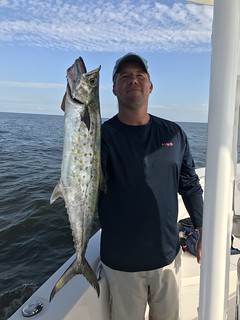

 1-888-373-7888
1-888-373-7888 233733
233733